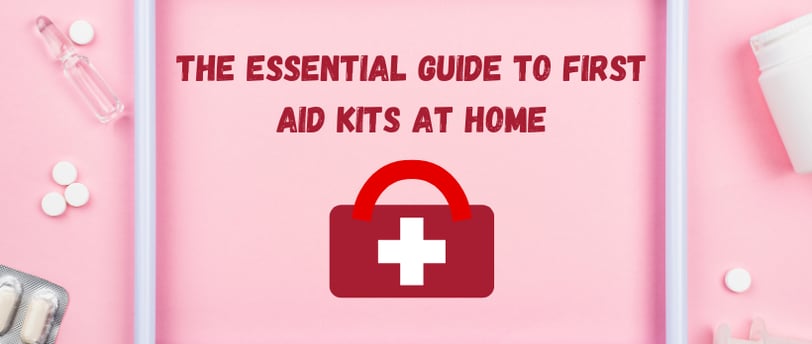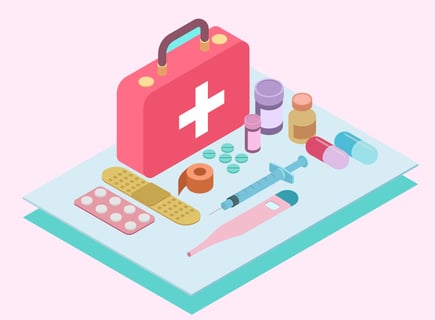The Essential Guide to First Aid Kits at Home
Aging with Grace is a journey that requires careful preparation, especially when it comes to health and safety. Having a well-stocked and properly organized first aid kit at home is crucial for every household, particularly for seniors. Accidents and injuries can happen unexpectedly, and being prepared with a well-equipped first aid kit can make a significant difference in providing immediate care before professional medical help arrives. In this article, we will explore the essential items that should be included in a basic first aid kit, along with some valuable tips for proper wound care, medications, emergency contact information, and more.
Dr. Rishabh Siddarth Harinarain - MBBS, PGDHM, Founder - Aging with Grace
7/15/20233 min read


In every household, especially those with seniors, having a well-equipped first aid kit is nothing short of a lifeline. This vital resource provides immediate care for minor injuries, offering peace of mind and convenience for seniors and their caregivers alike. Seniors may be more susceptible to accidents, and with the right supplies at hand, minor cuts, scrapes, bruises, and burns can be promptly attended to, reducing the risk of infections and complications. Moreover, a first aid kit becomes an indispensable asset in responding to medical emergencies or managing chronic health conditions, ensuring that seniors receive the initial care they need until professional help arrives. This sense of preparedness empowers seniors to maintain their independence, while caregivers find support in handling various health concerns. In our blog, we delve into the significance of a well-stocked first aid kit for seniors at home, exploring the diverse benefits it brings and how it fosters a safer, more secure living environment.
Basic First Aid Kit
A basic first aid kit should contain the following essential items:
Adhesive bandages in various sizes to cover cuts and minor wounds.
Sterile gauze pads and adhesive tape for dressing larger wounds.
Antiseptic wipes or solutions to clean the wounds and prevent infections.
Tweezers for removing splinters or foreign objects.
Scissors for cutting gauze, clothing, or other materials.
Disposable gloves to protect the caregiver from bodily fluids and contamination.
Instant cold packs for reducing swelling and pain in case of bruises or sprains.
A digital thermometer to monitor body temperature.
CPR face shield or mask for performing rescue breathing.


Wound Care and Bandaging
Proper wound care is essential to prevent infections and aid in the healing process. When attending to a wound, follow these steps:
Wash your hands thoroughly before touching the wound.
Gently clean the wound with mild soap and water or an antiseptic wipe.
Apply an antibiotic ointment and cover the wound with a sterile dressing or bandage.
Change the dressing daily or as needed, and monitor the wound for signs of infection.
Medications and Ointments
Including some over-the-counter medications and ointments in your first aid kit can provide initial relief for various ailments and injuries. Consider adding:
Pain relievers like acetaminophen or ibuprofen for headaches, fevers, and minor aches.
Antihistamines for allergic reactions and insect bites.
Hydrocortisone cream for soothing itching and rashes.
Aloe vera gel for treating minor burns and sunburns.
Tools and Instruments
Certain medical tools and instruments can be extremely helpful in managing injuries and medical situations at home. Consider adding these items to your first aid kit:
Oral or digital thermometer to monitor body temperature.
Medical scissors and tweezers for cutting and removing foreign objects.
Instant cold packs for reducing swelling and pain.
A flashlight with extra batteries to examine injuries in low-light situations.
Emergency Contact Information
In case of a medical emergency, having important contact numbers readily available is crucial. Along with local emergency services, include the following contacts in your first aid kit:
Family doctor's contact number.
Have a list of important Helpline Numbers printed
Any specific emergency contact information relevant to your region.
Additional Items
Depending on your family's specific needs or medical conditions, consider adding these additional items to your first aid kit:
EpiPen or other prescribed emergency medications for severe allergic reactions.
Medications and supplies specific to chronic medical conditions (e.g., asthma inhaler).
Personal protective equipment (PPE) such as masks and hand sanitizers.
Instant glucose for individuals with diabetes.
Medical information card with details about allergies and existing medical conditions.
Storage and Maintenance
Place your first aid kit in a easily accessible and well-known location, preferably in the kitchen or bathroom. Make sure all family members know where it is kept. Regularly check the kit for expired items and restock supplies as needed to ensure its readiness.
A well-prepared first aid kit is an indispensable asset for every household. By assembling the right items and gaining proper education, you can confidently respond to minor injuries and medical emergencies. At 'Aging with Grace,' we understand the importance of being proactive about healthcare, and our expert home healthcare services are here to support you and your loved ones. Start assembling your first aid kit today and age gracefully with preparedness and peace of mind.
Call +91 9363023232 for further information or to learn more about our personalized care plans and how we can help you age gracefully with preparedness and peace of mind.


Let's talk!
info@agingwithgrace.in
+91 93630 23232
River View Enclave, Manapakkam
Chennai - 600125
